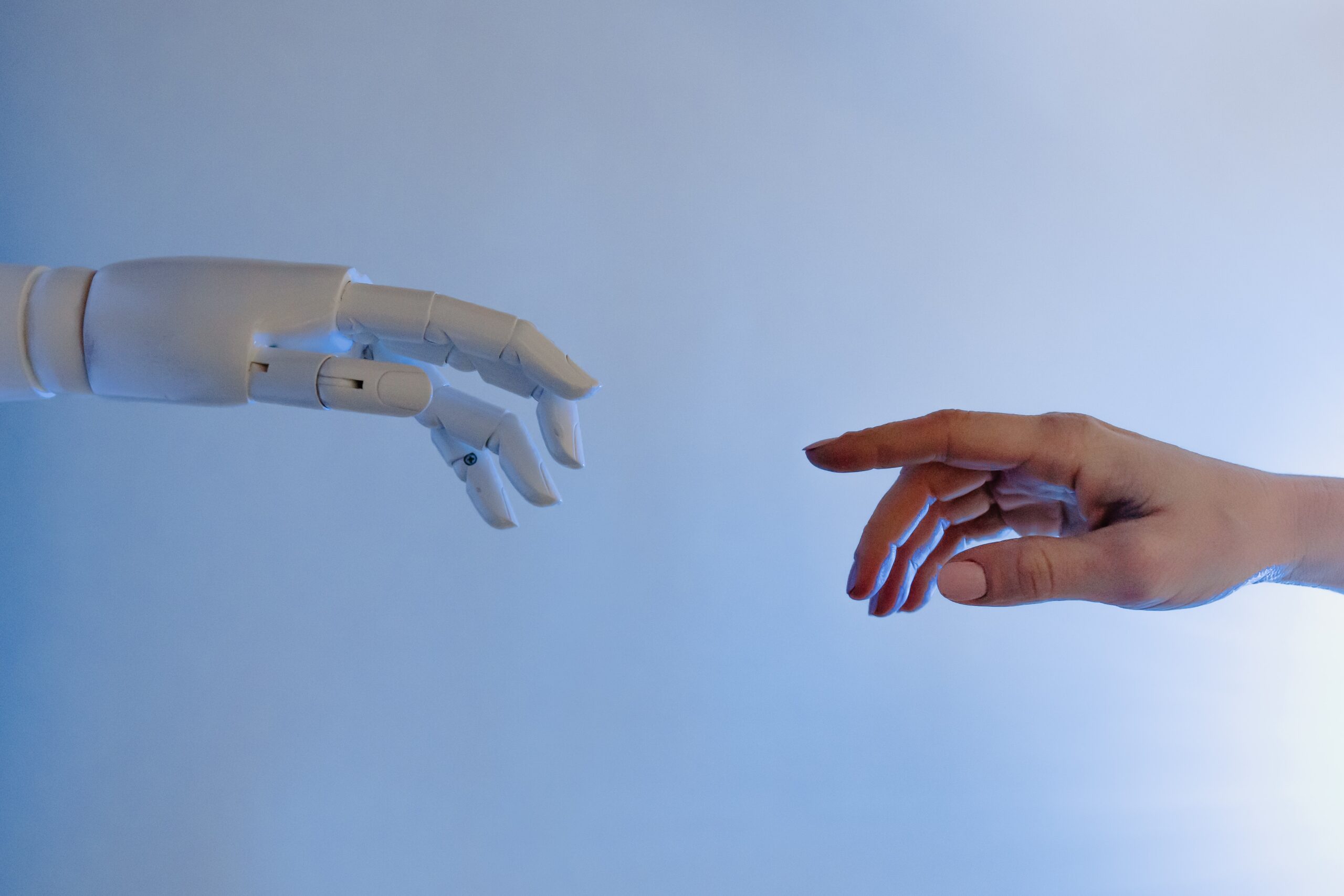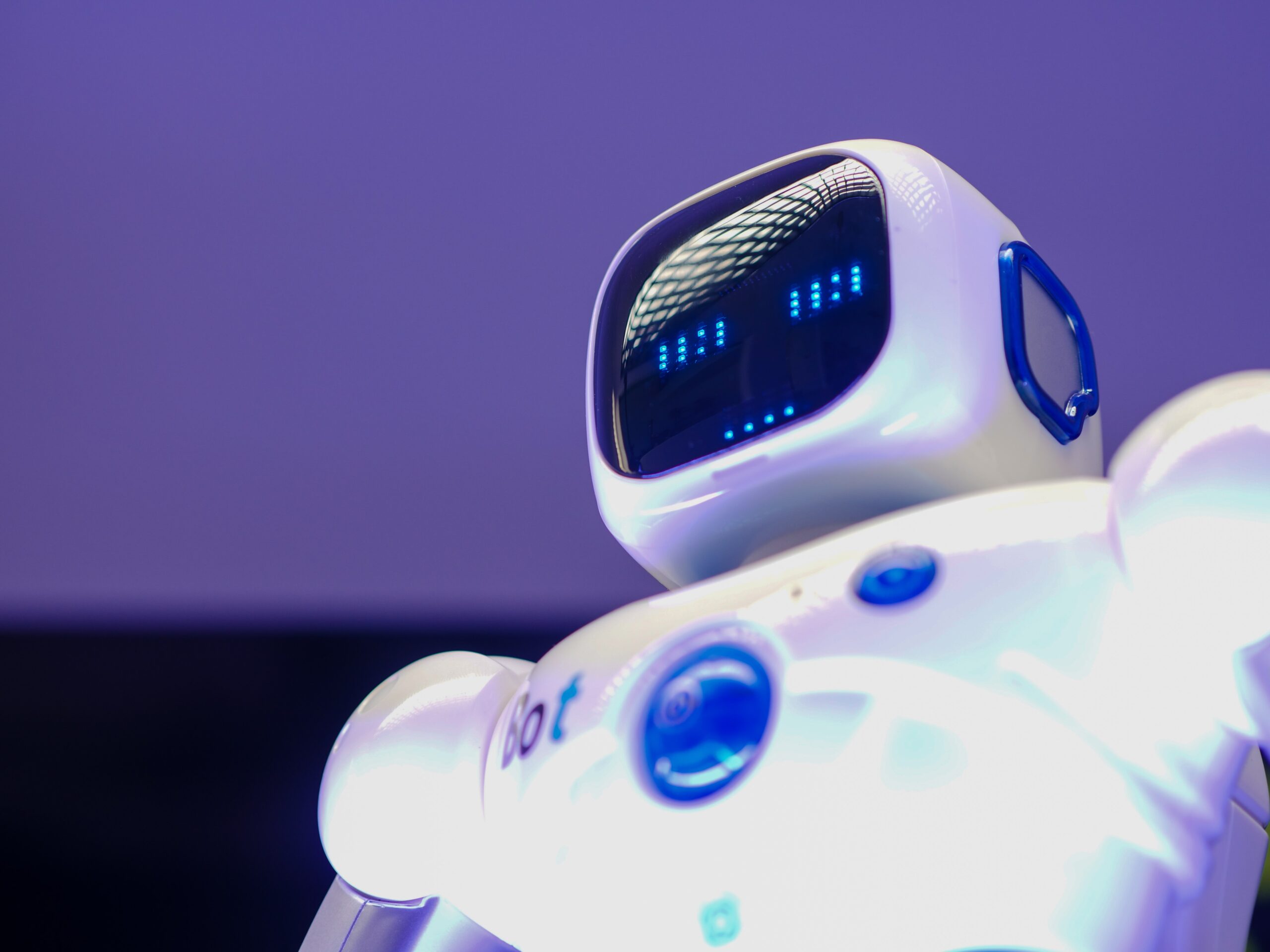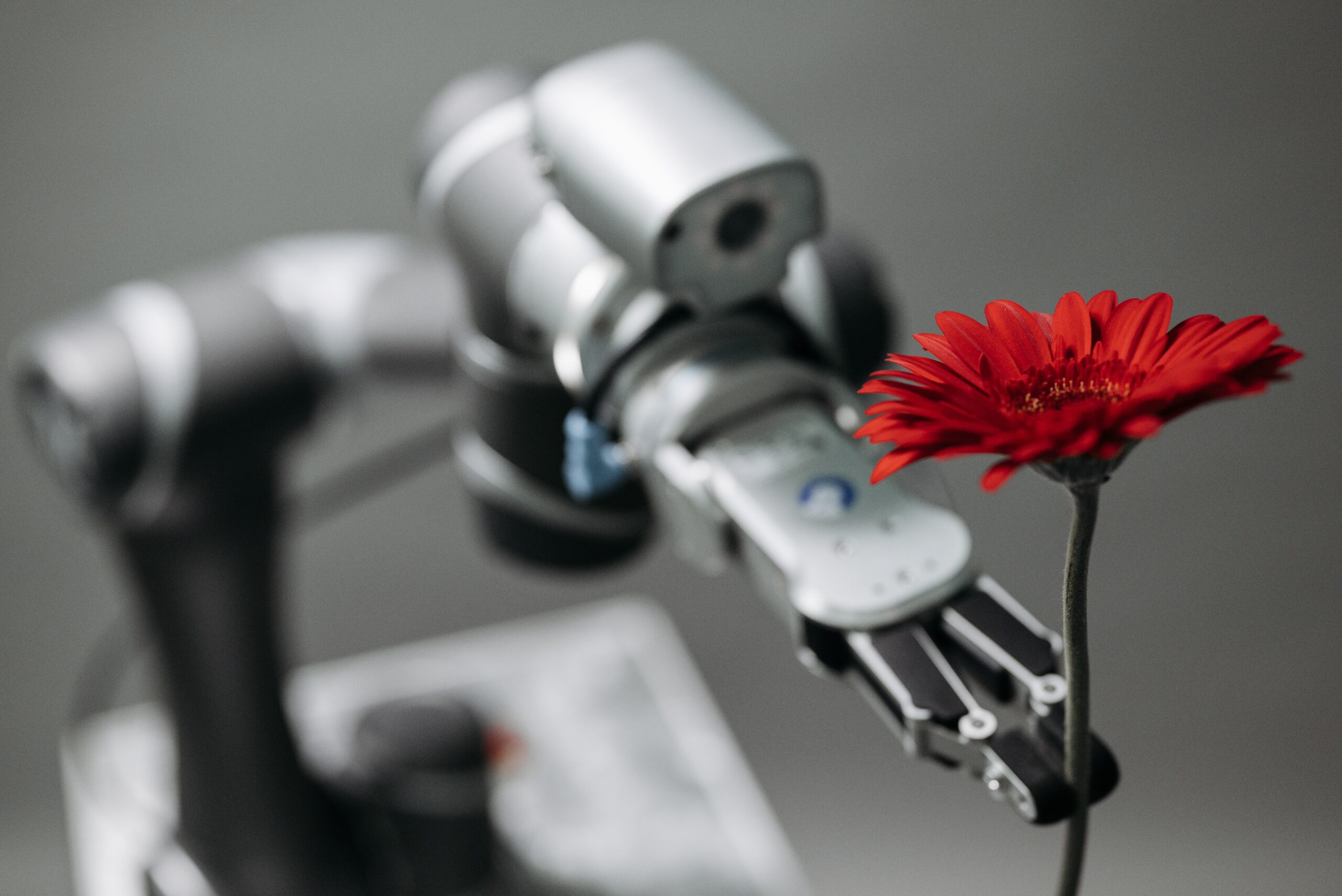How AI (Artificial Intelligence) Is Changing The World

Ladies and gentlemen, gather ’round, because I’m about to spill the beans on how AI is shaking up our world – and trust me, it’s not just about making your toaster start a podcast.
Picture this: you wake up in the morning to your AI alarm clock, which not only wakes you up with soothing music but also provides a full weather report, life advice, and a motivational speech that puts Tony Robbins to shame. It’s like having a life coach that’s just a few beeps away.
Now, let’s talk about shopping. Say goodbye to wandering aimlessly in malls – AI personal shoppers know your taste better than you do. They’ve cracked the code of your fashion sense and are ready to recommend outfits that scream, “I’m on top of my game!” Or, you know, at least “I’m dressed.” 🙂
Speaking of outfits, AI has revolutionized laundry day. Your washing machine can now negotiate with your clothes to see who’s ready for a spin cycle. If your socks could talk, they’d be thanking AI for their newfound voice in the household decision-making process.
Remember those awkward moments when you can’t remember someone’s name? Fear not, because AI is here to save you from embarrassment. It’ll discreetly whisper the name in your ear, ensuring you greet everyone like a memory superstar.
But wait, there’s more! AI is taking on the world of art. It can paint like Picasso, write like Shakespeare, and even compose music that’s so catchy, even your showerhead starts humming along. It’s like having an entire creative team at your fingertips, minus the studio snacks.
Of course, AI isn’t without its quirks. Sometimes it gets a bit carried away and starts predicting things like “Next, you’ll want to try a pineapple pizza with anchovies.” Yeah, thanks for the culinary advice, AI, but some lines should never be crossed.
So there you have it, folks. AI is changing the world – from the mundane to the downright absurd. Just remember, when your vacuum cleaner starts giving TED talks, don’t say I didn’t warn you. And if you ever find your blender discussing philosophy with the toaster, just go with it – the AI revolution is in full swing!
Automation:
Automation refers to the use of technology, such as AI, to perform tasks or processes without human intervention. This automation can range from simple, rule-based tasks to complex decision-making processes. Here’s how AI-driven automation is transforming industries and enhancing efficiency:
- Manufacturing and Production: AI-powered robots and machines are increasingly taking over repetitive and labor-intensive tasks on factory floors. These machines can assemble products, perform quality checks, and handle hazardous materials, leading to faster production, improved quality, and reduced human errors.
- Logistics and Supply Chain: AI optimizes the movement of goods by analyzing data from sensors, GPS, and weather forecasts. This ensures efficient routing, timely deliveries, and reduced operational costs.
- Customer Service: AI chatbots and virtual assistants are transforming customer interactions. They handle routine inquiries, troubleshoot issues, and provide 24/7 support, improving customer satisfaction and freeing up human agents for more complex tasks.
- Data Entry and Processing: AI-powered software can automate data entry and processing tasks, reducing the time and effort required for manual data input and validation.
- Financial Services: AI algorithms can automate routine financial tasks such as transaction categorization, fraud detection, and credit risk assessment. These streamlines operations and minimizes human errors.
- Healthcare: Automation in healthcare ranges from scheduling appointments to managing medical records. AI systems can also assist in monitoring patients’ vital signs and alerting medical staff to any anomalies.
- Document Processing: AI-powered systems can extract relevant information from documents, contracts, and invoices, saving time and minimizing the risk of overlooking critical details.
- E-commerce: AI-driven recommendation systems analyze customer preferences and behaviors to suggest personalized products, enhancing the shopping experience and boosting sales.
- Energy Management: AI algorithms optimize energy consumption in buildings and industrial processes, reducing waste and lowering energy bills.

Efficiency:
Efficiency in the context of AI-driven automation refers to the improved utilization of resources, reduced costs, and minimized waste in various processes. Here’s how AI contributes to increased efficiency:
- Faster Decision-Making: AI systems can quickly analyze large datasets and provide insights that humans might take much longer to deduce. This accelerates decision-making processes and strategic planning.
- Predictive Maintenance: AI analyzes data from sensors to predict when equipment or machinery is likely to fail. This enables maintenance teams to perform repairs before breakdowns occur, reducing downtime and production losses.
- Resource Allocation: AI optimizes resource allocation by analyzing data and determining the most effective distribution of resources such as manpower, raw materials, and energy.
- Reduced Errors: Automation through AI eliminates the risk of human errors and inconsistencies, leading to higher accuracy in tasks such as data entry, calculations, and quality control.
- Scalability: AI-driven automation can be easily scaled up or down based on demand, ensuring that resources are allocated efficiently without unnecessary waste.
- Cost Savings: By automating tasks that would otherwise require human labor, businesses can reduce labor costs and improve overall operational efficiency.
- Personalization: AI’s ability to analyze individual preferences and behaviors enables businesses to offer personalized products and services, leading to higher customer satisfaction and loyalty.
In essence, AI-driven automation enhances efficiency by taking over repetitive tasks, optimizing processes, reducing errors, and enabling quicker and more informed decision-making. This transformation has far-reaching implications for various industries, ultimately leading to increased productivity, reduced costs, and improved customer experiences.
Healthcare Revolution through AI:
The healthcare industry is experiencing a profound revolution due to the integration of AI technologies. These advancements are transforming every aspect of healthcare, from diagnostics to treatment and patient care. Here’s how AI is revolutionizing healthcare:
- Advanced Diagnostics: AI algorithms are capable of analyzing medical images such as X-rays, MRIs, and CT scans with remarkable accuracy. They can detect early signs of diseases like cancer, stroke, and cardiovascular conditions, allowing for timely intervention.
- Personalized Treatment Plans: AI analyzes a patient’s medical history, genetic information, and other relevant data to develop personalized treatment plans. This enables more targeted and effective therapies, minimizing adverse effects.
- Drug Discovery and Development: AI expedites the drug discovery process by predicting the interactions between compounds and biological systems. This reduces the time and cost involved in bringing new medications to market.
- Health Monitoring: Wearable devices and sensors equipped with AI can continuously monitor patients’ vital signs and alert medical professionals in case of anomalies. This proactive approach helps prevent medical emergencies.
- Electronic Health Records (EHR) Management: AI assists in managing and analyzing electronic health records, ensuring accurate patient data, and aiding in clinical decision-making.
- Natural Language Processing (NLP): NLP enables AI systems to understand and interpret medical texts, allowing for quick retrieval of information from medical literature and aiding clinicians in staying updated with the latest research.
- Robot-Assisted Surgery: AI-driven robots assist surgeons by enhancing precision and stability during complex procedures, resulting in reduced trauma, faster recovery, and improved patient outcomes.
- Predictive Analytics: AI algorithms analyze patient data to predict disease outbreaks, trends, and patterns, enabling healthcare providers to allocate resources effectively and plan interventions.
- Remote Consultations: AI-powered chatbots and virtual assistants offer patients quick access to medical advice and information, especially in regions with limited healthcare resources.
- Clinical Trials Optimization: AI streamlines the recruitment of suitable patients for clinical trials, expediting the research process and accelerating the development of new treatments.
- Radiation Therapy Planning: AI optimizes radiation therapy planning by determining the optimal dosage and targeting of radiation, minimizing damage to healthy tissues.
- Genomic Analysis: AI analyzes genomic data to identify genetic markers associated with diseases, enabling early detection and personalized treatment strategies.
Benefits of the Healthcare Revolution:
- Faster and Accurate Diagnoses: AI-enabled diagnostics lead to early detection and better accuracy in identifying diseases, improving patient outcomes.
- Personalized Medicine: Treatment plans tailored to individual patient’s genetic and medical profiles maximize effectiveness while minimizing side effects.
- Efficient Resource Allocation: AI assists in predicting patient admissions, allowing hospitals to manage resources more effectively.
- Cost Reduction: Early detection, preventive care, and streamlined processes contribute to cost savings for both healthcare providers and patients.
- Improved Patient Experience: AI-enhanced patient monitoring, telemedicine, and virtual consultations enhance accessibility and convenience for patients.
- Medical Research Advancements: AI accelerates medical research, leading to breakthroughs in disease understanding, treatment development, and drug discovery.
Challenges and Considerations:
- Data Privacy and Security: AI requires access to vast amounts of patient data, raising concerns about privacy and security breaches.
- Regulatory Compliance: Ensuring that AI applications adhere to medical regulations and standards is essential to guarantee patient safety.
- Bias and Fairness: Biases present in training data can lead to skewed AI outcomes, disproportionately affecting certain demographics.
- Human Oversight: While AI can assist, human expertise and judgment remain crucial in healthcare decision-making.
Enhanced Decision-Making through AI:
Enhanced decision-making is a key benefit of integrating AI into various industries and domains. AI technologies, particularly machine learning, and data analytics, empower organizations and individuals to make more informed, accurate, and timely decisions. Here’s how AI contributes to enhanced decision-making:
- Data Analysis and Insights: AI can process and analyze vast amounts of data from various sources, uncovering patterns, trends, and correlations that humans might overlook. This data-driven approach provides actionable insights for decision-makers.
- Predictive Analytics: By analyzing historical data, AI algorithms can make predictions about future trends, behaviors, and outcomes. This helps organizations anticipate changes and plan accordingly.
- Real-time Monitoring: AI systems can continuously monitor data streams in real-time, identifying anomalies or deviations from expected patterns. This allows for rapid responses to emerging situations.
- Risk Assessment: In finance and other industries, AI assesses risk by analyzing historical and market data, aiding in making investment decisions, managing portfolios, and mitigating risks.
- Supply Chain Optimization: AI optimizes supply chain operations by analyzing demand forecasts, inventory levels, transportation data, and other factors to make informed decisions about procurement and distribution.
- Customer Insights: AI analyzes customer data to understand preferences, behaviors, and purchasing patterns. This information informs marketing strategies and product development.
- Strategic Planning: AI helps organizations develop data-driven strategies by analyzing market trends, competitive intelligence, and internal performance metrics.
- Medical Diagnosis and Treatment: AI assists medical professionals in diagnosing diseases and developing treatment plans by analyzing patient data and comparing it with vast medical knowledge databases.
- Energy Management: AI-driven systems analyze energy consumption patterns to optimize usage, reduce costs, and minimize environmental impact.
- Human Resources: AI aids in recruitment by analyzing resumes and identifying candidates whose skills match job requirements. It can also predict employee turnover and recommend retention strategies.
Benefits of Enhanced Decision-Making with AI:
- Accuracy and Consistency: AI processes data without bias or fatigue, leading to more accurate and consistent decision-making.
- Speed: AI can analyze vast datasets in a fraction of the time it would take a human, enabling rapid decision-making, especially in time-sensitive situations.
- Complex Pattern Recognition: AI excels at recognizing intricate patterns and correlations in data that might be difficult for humans to discern.
- Data-Driven Insights: Decision-makers receive data-driven insights, reducing reliance on intuition and gut feelings.
- Cost Efficiency: Inefficient decisions can lead to financial losses. AI’s ability to optimize processes helps minimize operational costs.
- Informed Strategy: Organizations can develop strategies backed by comprehensive data analysis, increasing the chances of success.
Challenges and Considerations:
- Data Quality: AI’s effectiveness depends on the quality of input data. Inaccurate or biased data can lead to flawed decisions.
- Interpretability: Complex AI models can be difficult to interpret, raising concerns about the transparency of decision-making processes.
- Human Oversight: While AI provides insights, human judgment remains essential in evaluating AI-generated recommendations and considering ethical and contextual factors.
- Ethical Concerns: AI’s decision-making can inadvertently perpetuate biases present in training data, requiring careful monitoring and mitigation.
In conclusion, enhanced decision-making through AI enables organizations to leverage data-driven insights for better outcomes. By harnessing AI’s capabilities, industries can navigate complexities, identify opportunities, and make more informed choices in a rapidly evolving world.
NLP (Natural Language Processing):
Natural Language Processing is a branch of artificial intelligence concerned with the interaction of computers and human languages. Its major goal is to enable machines to understand, interpret, and synthesize meaningful and valuable human language. NLP includes a wide range of tasks involving the processing and analysis of text or speech input.
Key Components and Tasks of NLP: Text Analysis and Tokenization: NLP involves breaking down text into smaller units, or tokens, such as words and phrases.
This approach enables computers to comprehend the structure of a document and extract relevant information.
NLP recognizes the grammatical components of speech (nouns, verbs, adjectives, and so on) in a sentence, allowing machines to grasp the syntactic structure of language.
Named Entity Recognition (NER):
NER identifies and categorizes named entities in text, such as people’s names, organizations’ names, locations, dates, and so on.
Sentiment Analysis: NLP determines the sentiment or emotion expressed in a piece of text, whether it’s positive, negative, or neutral. This is valuable for gauging public opinion and customer sentiment.
Language Translation: NLP systems can automatically translate text from one language to another, enabling cross-lingual communication and accessibility.
Speech Recognition: NLP translates spoken language into written text, enabling voice commands, transcription services, and more.
Language Generation: NLP can generate human-like text based on given prompts. This is used in chatbots, content creation, and even automated news articles.
Question Answering: NLP systems can understand and answer questions posed in natural language by extracting relevant information from text sources.
Topic Modeling: NLP identifies and extracts topics or themes from a collection of text documents, aiding in content categorization and information retrieval.
Summarization: NLP systems can condense lengthy text into shorter, coherent summaries while retaining the essential information.
Applications of NLP:
Applications of NLP:
- Virtual Assistants and Chatbots: NLP powers virtual assistants like Siri, Alexa, and Google Assistant, allowing users to interact with devices and obtain information through natural language conversations.
- Customer Support: NLP-driven chatbots provide automated customer support, addressing queries and resolving issues in real-time.
- Search Engines: NLP enhances search engine capabilities by understanding user queries and providing relevant search results.
- Social Media Analysis: NLP analyzes social media content to track trends, sentiment, and public opinions on various topics.
- Medical Text Analysis: NLP assists in extracting insights from medical literature, patient records, and clinical notes to aid in diagnoses and treatment planning.
- Language Translation Services: NLP systems like Google Translate enable instant language translation, facilitating communication across different languages.
- Content Recommendation: NLP algorithms analyze user preferences and behavior to recommend relevant content, products, or services.
Challenges and Considerations:
- Ambiguity: Natural language often contains ambiguities, slang, and cultural references that can be challenging for NLP systems to interpret accurately.
- Contextual Understanding: NLP systems struggle with understanding context and nuances, which can lead to misinterpretations.
- Data Quality and Bias: The performance of NLP models heavily relies on the quality and diversity of the training data. Biased training data can result in biased outcomes.
- Privacy Concerns: NLP involves processing text and speech data, which can raise privacy and data security concerns.
Education and Learning with AI:
The integration of AI in education is revolutionizing the way people learn, teach, and interact with educational content. From personalized learning experiences to automated administrative tasks, AI is reshaping education at all levels. Here’s how AI is making an impact:
1. Personalized Learning: AI-powered educational platforms analyze students’ learning styles, preferences, strengths, and weaknesses. This enables the creation of customized learning paths, content, and assessments tailored to individual students’ needs, maximizing engagement and comprehension.
2. Adaptive Learning Systems: AI algorithms track students’ progress in real-time and adjust the difficulty and pace of learning materials accordingly. This ensures that students are appropriately challenged and not overwhelmed by the content.
3. Intelligent Tutoring Systems: AI-driven virtual tutors provide instant feedback and explanations to students as they work through problems. These systems offer a supportive learning environment, offering explanations and guidance similar to a human tutor.
4. Automating Administrative Tasks: AI handles administrative tasks like grading assignments and assessments, freeing up teachers’ time to focus on more meaningful interactions with students.
5. Language Learning: AI-powered language learning apps use speech recognition and natural language processing to provide immersive language practice and help learners improve their speaking, writing, and comprehension skills.
6. Early Intervention and Special Needs: AI identifies students who may be struggling early on and provides targeted interventions to address learning gaps. It’s particularly beneficial for students with special needs, as it can provide tailored support and accommodations.
7. Virtual Classrooms and Distance Learning: AI facilitates virtual classrooms by providing real-time translation, and transcription, and facilitating interaction between students and teachers from different parts of the world.
8. Education Content Creation: AI can generate educational content like quizzes, flashcards, and study guides, saving educators time and ensuring consistent quality.
9. Grading Assistance: AI-powered systems assist in grading multiple-choice questions and assignments, reducing the administrative burden on teachers.
10. Education Research and Insights: Educational institutions use AI to analyze data on student performance and behavior, providing insights that inform teaching strategies and curriculum development.
Benefits of AI in Education and Learning:
- Personalized Learning: AI tailors learning experiences to individual student needs, improving engagement and retention.
- Efficiency: Administrative tasks are automated, allowing educators to focus more on teaching and interacting with students.
- Accessibility: AI offers adaptive tools for students with disabilities, making education more inclusive.
- Data-Driven Decisions: Educators can make data-driven decisions by analyzing student performance and learning patterns.
- Global Access: AI-enabled platforms provide access to education to people in remote or underserved areas.
- Continuous Improvement: AI analytics help refine teaching methods and materials for better outcomes.
Challenges and Considerations:
- Data Privacy: Handling student data requires robust privacy and security measures to protect sensitive information.
- Bias and Fairness: AI systems can inadvertently perpetuate biases present in training data, affecting students’ learning experiences.
- Teacher Role: While AI can enhance teaching, human educators remain essential for mentorship, motivation, and emotional support.
- Digital Divide: Ensuring equitable access to AI-powered education tools is crucial to prevent furthering educational disparities.
In conclusion, AI is transforming education and learning by making it more personalized, efficient, and accessible. As technology continues to evolve, educators and policymakers must collaborate to harness the potential of AI while addressing its challenges to create a more effective and inclusive education system.
Autonomous Vehicles:
Autonomous vehicles, also known as self-driving cars or self-driving cars, are vehicles that are outfitted with advanced technologies that enable them to move and operate without the need for direct human intervention. These vehicles sense their surroundings, make judgments, and manage their motions using a combination of sensors, cameras, radars, lidars (light detection and ranging), GPS, and sophisticated software.
Levels of automation:
The Society of Automotive Engineers (SAE) classifies vehicle automation into six levels:
Level 0 – No Automation:
The human driver is entirely responsible for all aspects of driving. Level 1 – Driver Assistance: The vehicle may assist with either steering or acceleration/deceleration tasks, but not both simultaneously.
Level 2 – Partial Automation:
The vehicle can control both steering and acceleration/deceleration simultaneously under certain conditions. However, the driver must remain engaged and monitor the environment.
Level 3 – Conditional Automation:
The vehicle can manage all aspects of driving within specific conditions or scenarios. The driver can disengage from driving tasks but must be ready to take control if prompted by the system.
Level 4 – High Automation:
The vehicle can operate autonomously within defined operational domains or environments without human intervention. However, it might require a human driver in exceptional situations.
Level 5 – Full Automation:
The vehicle can perform all driving tasks under all conditions without any human intervention. No steering wheel or controls are necessary, as the vehicle operates like a “robot taxi.”
Key Components and Technologies:
Sensors: Autonomous vehicles are equipped with various sensors like cameras, lidar, radar, and ultrasonic sensors to gather information about the vehicle’s surroundings.
Perception Systems: These systems interpret sensor data to identify objects, pedestrians, other vehicles, road markings, and traffic signals.
Localization and Mapping: Autonomous vehicles use GPS and high-definition maps to determine their precise location and navigate accurately. Control Systems: AI algorithms process sensor data to make real-time decisions, such as steering, accelerating, and braking, to navigate safely.
Communication Systems: Vehicles can communicate with each other (V2V) and with infrastructure (V2I) to enhance safety and traffic management. Impact and Benefits:
Safety: Because AI systems are not prone to distractions or exhaustion, autonomous cars have the potential to drastically minimize accidents caused by human mistakes.
Autonomous vehicles could provide mobility alternatives for the aged, disabled, and those who are unable to drive.
Autonomous vehicles can communicate with one another, optimizing traffic flow and minimizing congestion.
Environmental Impact: More efficient driving and reduced congestion could lead to lower fuel consumption and emissions. Productivity: Commuters could reclaim time spent driving, using it for work, relaxation, or leisure. Urban Planning: Cities might evolve with reduced need for parking space and redesigned traffic infrastructure.
Challenges and Considerations:
Regulations and Laws: Developing appropriate regulations and laws to govern autonomous vehicles is complex and requires international cooperation. Transition Period: The transition from human-driven to autonomous vehicles may introduce a mix of vehicles on the road, posing challenges for interaction.
Cybersecurity: Self-driving cars are subject to hacking and cyberattacks, which might jeopardize their safety and privacy.
To summarize, autonomous vehicles have the ability to alter transportation by reinventing how we move and interact with our surroundings. While substantial progress has been made, fully integrating autonomous vehicles into our society will necessitate overcoming technical, legislative, and ethical hurdles to assure their safe and responsible adoption.
Pros & Cons Of AI

Pros of AI:
| Pros of AI | Description |
|---|---|
| Automation | AI automates repetitive tasks, reducing human effort and enabling efficient use of resources. |
| Data Analysis | AI processes vast datasets quickly, extracting insights and patterns for informed decision-making. |
| Precision and Accuracy | AI systems perform tasks with high precision, minimizing errors and improving quality. |
| 24/7 Availability | AI-powered systems can work around the clock, providing continuous services and support. |
| Personalization | AI tailors recommendations and experiences based on individual preferences and behavior. |
| Learning and Adaptation | AI systems learn from data and user interactions, improving performance over time. |
| Complex Problem Solving | AI tackles complex problems by analyzing data, simulations, and patterns, aiding decision-making. |
| Medical Advances | AI aids in disease diagnosis, drug discovery, and personalized treatment plans in healthcare. |
| Safety and Risk Reduction | AI-controlled systems improve safety in areas like autonomous vehicles and industrial automation. |
Cons of AI:
| Cons of AI | Description |
|---|---|
| Job Displacement | Automation by AI could lead to job losses in certain industries, impacting the workforce. |
| Lack of Creativity | AI lacks true creative thinking and cannot replicate the depth of human artistic expression. |
| Ethical Concerns | AI decisions can raise ethical questions, such as bias in algorithms or autonomous vehicles. |
| Privacy and Security | AI’s reliance on data collection raises concerns about privacy breaches and data security. |
| Dependence on Technology | Overreliance on AI can result in reduced human skills and abilities, making us technology-dependent. |
| Unpredictability | Complex AI models can make decisions that are difficult to interpret or predict. |
| Initial Costs | Implementing AI technologies can involve high upfront costs for development and integration. |
| Limited Contextual Understanding | AI may struggle to understand context, humor, and emotional nuances in human interactions. |
| Environmental Impact | AI infrastructure and data centers contribute to energy consumption and carbon emissions. |
Pros and Cons of AI Chart:
Here’s a simple chart summarizing the pros and cons of AI:
| Pros of AI | Cons of AI |
|---|---|
| Automation | Job Displacement |
| Data Analysis | Lack of Creativity |
| Precision and Accuracy | Ethical Concerns |
| 24/7 Availability | Privacy and Security |
| Personalization | Dependence on Technology |
| Learning and Adaptation | Unpredictability |
| Complex Problem Solving | Initial Costs |
| Medical Advances | Limited Contextual Understanding |
| Safety and Risk Reduction | Environmental Impact |
Remember that the impact of AI can vary based on specific contexts and applications. Weighing these pros and cons helps us understand the multifaceted nature of AI’s influence on our lives.

FAQs
1. What in the World is AI? AI, or Artificial Intelligence, is like that friend who’s really good at pretending to be smart. It’s when computers act all brainy and do things that make you wonder if they’re secretly reading Shakespeare in binary.
2. Can AI Make My Coffee? Well, it won’t whip up a cappuccino with a fancy design, but AI can certainly help your coffee machine figure out the perfect brew time, temperature, and playlist to match your caffeine mood.
3. Will AI Replace My Pet Goldfish? No, your AI doesn’t want to swim around in a bowl, but it can remind you to feed your fish and suggest an ocean-themed screensaver to keep them company.
4. Can AI Tell Me if My Outfit is a Crime Against Fashion? While AI won’t judge your fashion choices (at least not out loud), it might suggest a more stylish combo if you’re considering pairing socks with sandals. Seriously, just don’t.
5. Is AI Going to Steal My Job? Only if your job involves endlessly pushing elevator buttons. AI might take over some tasks, but you’re still the reigning champion of witty office banter.
6. Can AI Write Me a Love Song? Sure, AI can write you a love song – just be prepared for lyrics like “You’re my data point, my binary star.” Hey, it’s the thought that counts, right?
7. Is AI Good at Small Talk? Well, AI might start with “How’s the weather?” and then launch into a TED Talk on climate change. So, maybe keep the chitchat about binary code and algorithms.
8. Can AI Predict If My Plants Are Plotting Against Me? Not yet, but AI can monitor your plant’s hydration levels and suggest a lullaby if they’re feeling a bit droopy. Paranoid plants, rejoice!
9. Is AI the New Nostradamus? Well, AI can predict trends, but it’s still working on predicting your aunt’s unpredictable holiday menu. Keep the AI, bring your appetite.
10. Can AI Teach My Dog to Fetch My Slippers? Sorry, AI can’t teach your dog new tricks, but it might suggest an app to help you remember where you left your slippers in the first place.
11. Will AI Understand My Sarcasm? Oh, absolutely. AI understands sarcasm as well as your cat understands why you’re late with the dinner bowl. Don’t worry; they’re both still awesome.
12. Can AI Make Me Breakfast in Bed? AI might not flip pancakes, but it can remind you that breakfast is the most important meal of the day. And if you spill syrup on your pajamas, well, that’s just a bonus.
13. Can AI Do the Moonwalk? Sorry, AI’s dance moves are limited to data shuffles. But if you need help analyzing Michael Jackson’s signature spin, it’s got you covered.
14. Is AI Smarter Than My Grandma? Well, your grandma has a lifetime of wisdom, but AI can calculate the square root of pi while reciting Shakespeare. It’s a close call.
15. Will AI Plan My Dream Vacation? AI can help you find the best deals, but if you’re hoping for AI to pack your suitcase and slather on sunscreen, you might need a vacation from reality.
Remember, while AI is smart and capable, it hasn’t quite mastered the art of stand-up comedy – but hey, that’s what humans are here for!




